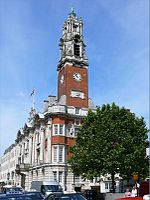Temple of Claudius, Colchester
1st-century establishments in Roman BritainBuildings and structures completed in the 1st centuryBuildings and structures in Colchester (town)ClaudiusPaganism in Europe ... and 3 more
Roman ColchesterRoman religious sites in EnglandRoman temples of the Imperial cult

The Temple of Claudius (Lat. Templum Claudii) or Temple of the Deified Claudius (Lat. Templum Divi Claudii) was a large octastyle temple built in Camulodunum, the modern Colchester in Essex. The main building was constructed between 49 and 60 AD, although additions were built throughout the Roman-era. Today, it forms the base of the Norman Colchester Castle. It is one of at least eight Roman-era pagan temples in Colchester, and was the largest temple of its kind in Roman Britain; its current remains potentially represent the earliest existing Roman stonework in the country.
Excerpt from the Wikipedia article Temple of Claudius, Colchester (License: CC BY-SA 3.0, Authors, Images).Temple of Claudius, Colchester
Exbomont,
Geographical coordinates (GPS) Address Nearby Places Show on map
Geographical coordinates (GPS)
| Latitude | Longitude |
|---|---|
| N 51.8906 ° | E 0.9031 ° |
Address
Exbomont 19
4987
Liège, Belgique
Open on Google Maps









